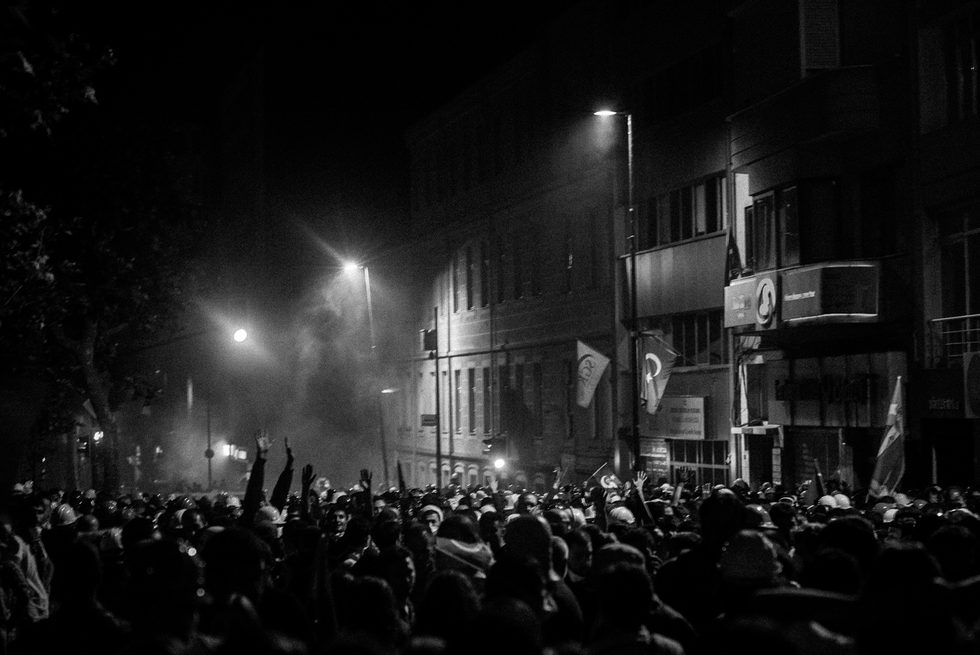Masculinized Power, Queered Resistance
From the Series: An Impromptu Uprising: Ethnographic Reflections on the Gezi Park Protests in Turkey
From the Series: An Impromptu Uprising: Ethnographic Reflections on the Gezi Park Protests in Turkey

On the morning of July 1, exhausted from the first night of clashes with the riot police but still upbeat, the crowd of young male soccer fans with eyes red from tear gas chanted, “Go on, spray, go on, spray. Go on spray tear gas. Strip your helmet, drop your baton. Let’s see who is the real man!” This would prove to be the most popular slogan of the protests. The political language of the resistance, personified by the soccer fan group Çarsı, was speaking in the lingo of urban poor male youth to challenge the policemen for a “manly” fight. The same lingo was also visible on the walls covered with sexually-offensive graffiti swearwords targeting Prime Minister Erdoğan.
During the Gezi Resistance, commentators on Turkish politics were surprised by Erdoğan’s seemingly irrational unwillingness to compromise with the protestors. Erdoğan was repeatedly criticized for being arrogant, brash, and stubborn. These alleged personal qualities might sit well with his condescending political style. Nevertheless, psychological explanations of his authoritarian style miss a deeper understanding of its cultural politics. In order to understand Erdoğan’s political style and how the Gezi Resistance has been forged in a dynamic relationship with the evocative gendered power embodied by Erdoğan, one has to examine this through the analytical lens of gender.
Erdoğan embodies a very particular gendered political persona that relies on an innovative (neoliberal) synthesis of Islamist and urban, tough masculinities. This masculine synthesis has been one of the main pedestals of his political charisma and successful political career. Just before the recent protests, Erdoğan recommended that Turkish women have three children, supported an alcohol ban, and, in the early days of the protests, reported that girls were sitting on men’s laps in Gezi Park. All of this was done to delegitimize the resistance movement. In other words, he had once again enacted the role of a husband who wanted three kids, a father who forbids drinking at night, and a brother who scolds his sister for socializing with males. However, in the course of the Gezi Resistance, his gendered relationship with Turkish citizens would take an unprecedented turn.
The slogans attacking Erdoğan’s masculine honor deployed the same masculine idiom that he used and despite, or perhaps exactly because of this, they became the voice of the masses resisting Erdoğan’s masculinized exercise of power. In other words, precisely because he played the role of the father, brother, and husband, the supposedly apolitical language of the resistance targeted Erdoğan’s masculinity through swearwords questioning his penis size, heterosexuality, and impenetrability. The language of the resistance engaged with, questioned, and answered Erdoğan through the imperatives of hegemonic masculinity.
On the one hand, the masculine language adopted by the resistance created a space to question and resist political authority. On the other hand,, its sexist, homo- and trans-phobic nature othered women, LGBT individuals, and sex workers who constituted one of the integral elements of the resistance movement. As a response, feminists and LGBT activists reclaimed, transformed, and queered this resistance language through different strategies. They covered (hetero)sexist graffiti on walls with purple paint, urged “no cursing of women, gays, and whores,” subverted chants (for example, by substituting “see the gays” for “see the real man”), contributed their own slogans (such as “Tayyip and harassment free zone”), and encouraged everyone to transform their language by inviting them to “resist by persevering, not by swearing.” Feminist “swearing workshops” were held in parks to collectively reinvent a non-sexist language. Sex workers carried placards that read, “We the whores are certain that Tayyip is not our child,” in response to the swearing slogans against Erdoğan.
Such subversive strategies proved useful in the reconstruction of the Gezi experience as a model for a new public space and political morality, which offers women and especially LGBT individuals not only relative freedom from harassment, sexual violence, and hate crimes, but also new and unexpected forms of alliances. The 2013 LGBT Pride March in late June that attracted tens of thousands of people with the massive participation of Gezi protestors was the first sign of such changes. Just this month, an act of “guerrilla beautification” triggered a new wave of anti-government protests, during which public stairs were painted in the rainbow colors of the LGBT flag. The Gezi resistance continues to reinvent itself; so do the feminist and LGBT movements in Turkey.